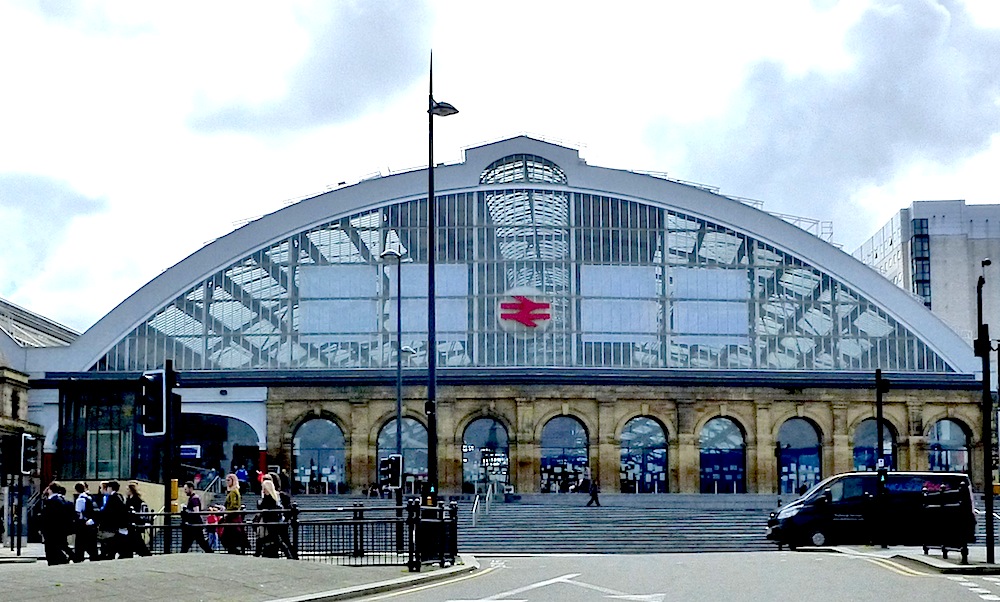In transcribing the following passage from the Internet Archive online version I have expanded abbreviations and added paragraphing, links, and illustrations. — George P. Landow

Crown Street Railway Station. Painted by T. T. Bury, engraved by S. G. Hughes. Source: Ramsay’s Bygone Liverpool. Click on image to enlarge it.
Four railway systems, gathering up and concentrating branch-lines as they approach, have terminal communications with Liverpool. One is the Great Western, coming to Birkenhead, and communicating by ferry-boat with Liverpool landing-stage; another is the Great Northern, and the Manchester, Sheffield, and Lincolnshire, coming originally to a station in Sefton-street, near the south docks, but extended since 1864 to a station at the end of Church-street, near the centre of the town; a third is the Liverpool and Manchester branch of the Northwestern, opened in 1830, the first passenger-railway in England, coming to a passenger-station in Lime-street, and sending off three branch-lines, for goods-trains, to respectively Wapping for the south end of the town, Waterloo-road for the north end of the town, and Bankfield-street, Kirkdale, for the north docks; and the fourth is the Lancashire and Yorkshire and the East Lancashire, coming to a station in Tithebarn-street.

Lime Street [The old London and North Western Railway station] Source: Ramsay Muir, Bygone Liverpool.
The station of the Great Western, though in Birkenhead, commands facile communication with Liverpool, both by its own excellent arrangements on the Cheshire side, and by the singularly effective construction of the landing-stages on both sides. Even the old station of the Great Northern and the Manchester, Sheffield, and Lincolnshire, at Sefton-street, gave good facilities of transit from London, Yorkshire, and Scotland; and was connected, by omnibuses, with an office in Lower Castle-strect.

Lime Street Station, Liverpool. 1849.
The Lime-street station of the Northwestern was erected in 1836, on the site of a cattle- market, whence Mr. Sadler rose in his balloon, a short time before his last and fatal ascent; is a magnificent and elaborate structure, extending in fnmt from Gloucester-street to Lord Nelson-street; borrows splendour from confronting St. George's Hall; has a stone façade 330 feet long, enriclied with thirty-six three-quarter Corinthian colunnis on rustic pedestals, and with other decorations; is pierced, in that façade, with four large gate-arches, two of which are blank, while the other two, at the extremities, are the entrances; has its offices in a receding form, under a porticoed Doric colonnade, surmounted by an extensive balcony; and is covered, over its platform, by a fine arched roof, 70 feet in span, formed of iron, and spaced with windows. A tunnel, 6,090 feet long, 25 feet wide, and 17 feet high, extemis hence to Edge-hill; and the trains are drawn up this tunnel by means of ropes and fixed engines, stationed at Edge-hill.
A stupendous cutting ocnirs in the railway's course, at Olive-Mount, about 1 ¼ mile beyond Edge-hill; and is, at one place, 70 feet deep. The branch line for goods to Wapping joins the main line at Edgehill; is upwards of 1 ¼ mile long; and all passes through a tunnel, principally hewn out of solid rock, beneath the town. The trains enter at Wapping, by an open cutting, with space for four lines of rails; pass under piles of warehouses, floored on rows of cast-iron pillars; receive their loads through trap-doors in the floors of the warehouses; and, like the passenger-trains from the Lime-street station, are drawn up the tunnel bymeans of ropes and fixed engines starioned at Edge-hill. The branch-lines for goods to Waterloo-road and to Bankfield-street, also pass through tunnels. The tunnel to Bankfield-street was formed in 1861-6; and the station there stands opiwsite the entrance of Huskisson dock, and was erected in 1866.
The Tithebarn-street station of the Lancashire and Yorkshire and the East Lancashire railways, serves also for the Liverpool and Southport, the Liverpool and Bury, and the Liverpool, Onnskirk, and Preston lines; is an edifice in the Italian style, 240 feet wide; and has a booking office 117 wide, with wings 193 feet.
The goods station of the Great Western is at Duke's-dock; the goods station of the Great Northern and the Manchester, Sheffield, and Lincolnshire, is at Sefton-street; goods stations of the Northwestern are at Crown-street, Great Howard-street, Park-lane, Wapping, Waterloo-road, and Bankfield- street; a cattle-station of the Northwestern is at Edgehill; goods stations of the Lancashire and Yorkshire are at Great Howard-street, Love-lane, North docks, Sand- hills, Bankfield-streer, Sefton-street, Brunswick dock, Battery-street, and Canada dock; and goods stations of the East Lancasldre are at Great Howard-street, and Sandhills bridge.
A project for a pneumatic railway between Liverpool and Birkenhead, to pass 25 feet below the bed of the Mersey was explained, near the end of 1865, by Sir Charles Fox, to a niimerous and influential meeting in Liverpool, and approved.
Bibliography
Muir, Ramsay, et al. Bygone Liverpool. Liverpool: Young, 1913. Internet Archive online version of a copy in the University of Toronto Library. Web. 20 September 2022.
Wilson, John M. (John Marius). The imperial gazetteer of England and Wales: embracing recent changes in counties, dioceses, parishes, and boroughs: general statistics: postal arrangements: railway systems, &c.; and forming a complete description of the country. 8 vols. Edinburgh: A. Fullarton, 1870.Internet Archive online version of a copy in the Allen County Public Library Genealogy Center. Web. 17 September 2022.
Last modified 19 September 2022